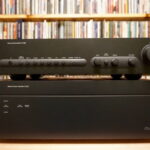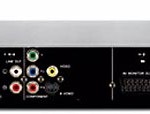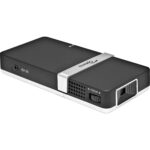There are two generally available types of loudspeaker, and the other type is known as the electrostatic. Conventional moving coil speakers based on two or more circular cone/dome drivers in a sealed or port vented enclosure have the advantage of simplicity and design flexibility. You can get acceptable sound from speakers not much bigger than a few matchboxes – ask Bose – and up the size of a substantial wardrobe, with performance (and price) scaling seamlessly with size.

But electrostatics can be incredibly thin, offer exceptional sound quality and can even dispense with the whole idea of boxes altogether.
So what are electrostatics?
The most common type use a large area lightweight diaphragm, usually a transparent polyester film to which an electrostatic charge is applied, stretched between perforated metal plates, the stators. The audio signal is applied via a transformer to these stators, and the diaphragm moves in response, the stator perforations allowing the sound to escape into the listening room.
So electrostatics look different – and they present certain difficulties for the designer and user alike. The diaphragms need to be large enough to generate a useful output, and this means they can't be mounted into normal enclosures as reflections from inside will pass unimpeded through the panel, muddling the forward radiated sound. So electrostatics are limited to use in large area panels, the area helping make up in bass output and acoustic power what is lost by not using a conventional enclosure.
In most but not all designs it is just the mid and high frequencies that are generated by the electrostatic panel, leaving the bass to be produced by a moving coil driver or drivers housed in a traditional enclosure which doubles as the base and support for the panel. This type of electrostatic is usually known as a 'hybrid electrostatic', or just 'hybrid' for short.
Problems
The problem for the user is that although the panels are thin, and sometimes even semi-transparent, their large surface area means they are physically intrusive. They need to be positioned with care too, typically a metre or more from the back wall (the good news is that electrostatics barely interact with the side walls). The reason? The sound is radiated equally forward towards the listener and to the back of the room, and the back radiation must be dispersed or time delayed so as not to adversely affect the direct sound.
As well as needing plenty of space, they can also be awkward system matches, requiring special care when choosing a matching amplifier which must be suitable for electrically reactive loads that can cause many amplifiers real problems, especially at high frequencies and at high volume levels. Even then, they don't generally produce the greatest bass output or the highest volume levels, which begs a rather obvious question – why bother? Why not stick with tried and tested technology?
Why bother?
Yes, you guessed. It's all to do with sound quality. Partly because the diaphragm is incredibly light and non-resonant, the sound of a good electrostatic has unrivalled delicacy, refinement, and transparency in the way it resolves the finest detail of quality recordings. There is a particular synergy with acoustic recordings in lively acoustic surroundings over recordings made in the studio, though in the not so black and white world of high grade audio there are exceptions in both directions. Those who like electrostatics generally love them, while those who don't are often strongly against.
There are some complications in the design of electrostatics that tends to make them more expensive than conventional speakers, and there is no such t hing s a tiny, low-cost electrostatic – such a beast would not work. A major reason why they are expensive however is that they are made in smallish numbers, and given their unsuitability for many typical smaller listening rooms, this is not about to change. But there is something fundamentally moving musically about a fine electrostatic in full flood, which is why for some it is the only solution worth considering.
hing s a tiny, low-cost electrostatic – such a beast would not work. A major reason why they are expensive however is that they are made in smallish numbers, and given their unsuitability for many typical smaller listening rooms, this is not about to change. But there is something fundamentally moving musically about a fine electrostatic in full flood, which is why for some it is the only solution worth considering.
Electrostatic speakers
Three of the best electrostatics we know…
Final 600i £3,395
Final website Final info
Danish company Final has effectively inverted the way electrostatics operate, retaining the benefits but easing the  amplifier match which helps them work in simpler, more cost-effective systems.
amplifier match which helps them work in simpler, more cost-effective systems.
The 600i is a relatively compact and affordable design, generally best used with a separate subwoofer.
Quad 2805 £4,500
Quad website Quad info
The 2805 is the latest iteration on the ESL63, the long-running full-range electrostatic mainstream model from the most famous of all electrostatic marques.
This model introduces new rigour to its physical construction, and retains the original's virtual point source radiation pattern, achieved by using internal delay lines.

MartinLogan Summit £9,498
MartinLogan website
This elegant hybrid electrostatic has addressed the design of the frame around the electrostatic panel in a novel way, which reduces the bulk of the final speaker, and helps it deliver a faster, more refined sound which responds unusually quickly to musical stimulation.







